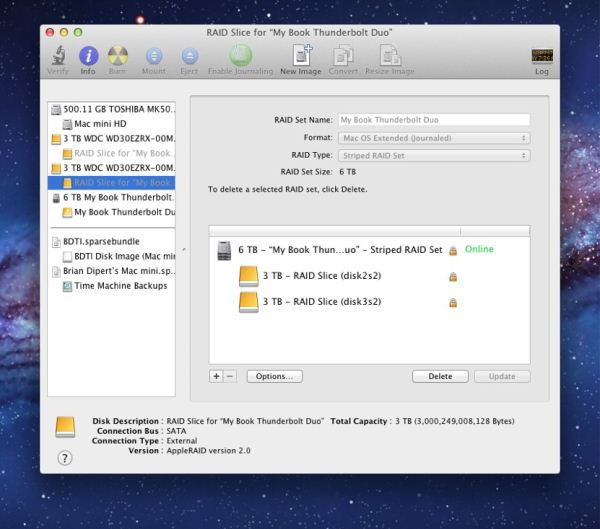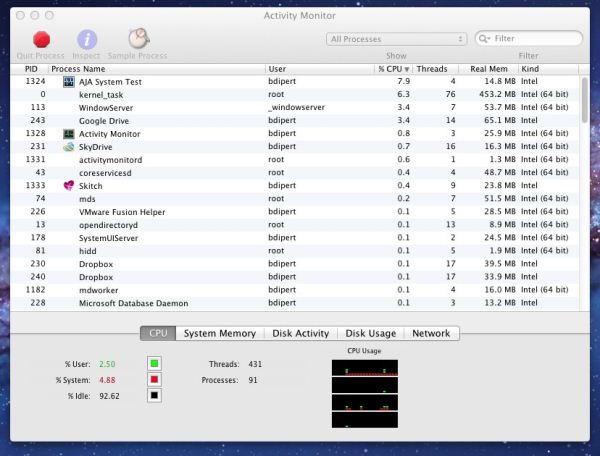A Tale Of Two Thunderbolt Storage Devices: Seagate's GoFlex Desk and Western Digital's Thunderbolt Duo
by Brian Dipert on May 13, 2012 7:52 PM EST- Posted in
- Thunderbolt
- Seagate
- WD
- Western Digital
My initial assumption had been that WD put a hardware RAID controller between the Thunderbolt interface and the two SATA HDDs, akin to what Promise had done with the Pegasus, and as has also been the case with any number of other dual-drive enclosures I've tested and otherwise used over the years. The fact that the Thunderbolt Duo didn't have configuration switches (an O/S-agnostic and otherwise convenient means of setting the RAID mode in hardware versus via a software utility) gave me pause, but not all hardware RAID controller-based enclosures I've used have had them.
However, after powering up the Thunderbolt Duo for the first time, I happened to fire up Mac OS X's built-in Disk Utility and received clear indication that the enclosure was (as with the LaCie Little Big Disk) instead leveraging Mac OS X's native software RAID facilities:
As previously mentioned, I promised my WD PR contact that I wouldn't take the enclosure apart. But I'm guessing that, akin to the LaCie Thunderbolt eSATA Hub that Anand saw at CES 2012, WD has built into the Thunderbolt Duo a Thunderbolt to dual SATA controller. Such a feature allows the system-side Thunderbolt controller to "see" each Thunderbolt Duo as a single bus peripheral, thereby enabling WD to accurately claim that you can daisy-chain numerous drives to each other and the system before you violate Apple's six-max specifications.
WD includes the installer for WD Drive Utilities, a status-and-configuration program, right on the Thunderbolt Duo, although I found (and downloaded, installed and used instead) an updated version of the utilities at the company's support website:
However, I found myself using Mac OS X's Disk Utility in this study instead, for several reasons (and with WD's official sanction, as it turns out). For one thing, Disk Utility offers the auto-rebuild-on-error option for RAID 1 (mirrored), a setting that isn't exposed in the WD program. Also left unexposed in the WD utility are the five block-size options (16KB, 32KB, 64KB, 128KB and 256KB) that Disk Utility supports for both RAID 0 and RAID 1; I'm assuming (but don't know for sure) that WD's program uses Mac OS X's 32KB default block size setting.
WD's program offers the "JBOD" ability to use the two HDDs as discrete drives, even optionally putting HFS+ on one and exFAT on the other, which is convenient for dual-O/S-booting purposes. However, surprisingly, the WD utility does not expose Disk Utility's 'Concatenate' option, which combines the two drives in a non-striped fashion. Although SPAN (i.e. BIG) is not an official RAID mode, it's commonly supported by RAID utilities. And curiously, although the WD utility doesn't support configuring the drives in SPAN mode, it correctly identifies a two-drive array that's already been concatenated via Disk Utility:
One historical reason (of many) for going with hardware RAID is that (versus software RAID) it didn't excessively burden the CPU, with both resultant system battery life and performance impacts. Thankfully, if my experiments are indicative of a broader conclusion, those days are over. Note that the kernel_task process reports using only around 6% of one core of the CPU during heavy use of the Thunderbolt Duo in RAID 0 mode, and that the system reports four cores (thanks to HyperThreading virtualization):
Given that kernel_task typically consumes 3-4% of a CPU core under normal operating conditions, an extra few-percent load for heavily utilized software RAID is, in my opinion, quite acceptable.



















46 Comments
View All Comments
rruscio - Sunday, May 13, 2012 - link
I don't care much for speeds and feeds, but I care a lot about reliability and subsystem dis-integration.When I get a cpu / memory 'box', that requires a Thunderbolt connection to a 'video card / cards' box, and a connection to a mass storage 'box', so that I can mix and match and replace/upgrade as needed, I'll care about Thunderbolt.
Till then, thanks, but really ...
rr
StevoLincolnite - Sunday, May 13, 2012 - link
Yeah I'm with you. I honestly couldn't give a rats about thunderbolt.The only devices that I would personally see benefit from is External Hard Drives, and lets face it... USB 3 isn't exactly holding back mechanical drives much. (Except for exotic raid solutions.)
peterfares - Monday, May 14, 2012 - link
And eSATA is superior to USB 3.0 and equivalent to Thunderbolt in speed. It's also EXTREMELY cheap to implement, just costing the price of one USB/eSATA receptacle. Every chipset has at least 4 SATA ports, only 2 are usually used in most laptops (HDD, ODD). All you need to do for eSATA is route one of the SATA ports to the receptacle and you're done.For eSATA hard drives
CPU->PCIe->SATA controller->HDD
For USB hard drives
CPU->PCIe->USB 3.0 Controller->SATA Controller->HDD
For Thunderbolt
CPU->PCIe->SATA controller->HDD
I believe the thunderbolt multiplexing chips do not affect performance
Guspaz - Monday, May 14, 2012 - link
eSATA itself is nearly useless. The two sticking points are that it's a port dedicated to nothing but external HDDs, and that it has no power and so you end up needing to plug your HDD into a wall socket or USB port anyhow. From a consumer standpoint, USB3 wins that by default because consumers don't want to carry around a power brick when they could just use USB3 and plug the drive in right there.eSATAp (a combination USB and eSATA) port helps, and provides some power, but has issues the same. The USB standards body refuses to recognize them as valid USB ports, the eSATA part of the expansion is useless for anything but disks, and it doesn't provide enough power for 3.5" mobile drives (since it only does 2.5W). It also doesn't really jive with storage arrays, which want to expose something higher-level than SATA if they're doing hardware RAID.
USB3 helps: you get enough bandwidth for disks, but also for other high-bandwidth devices, and the 5W it provides is an improvement. It still can't do displays very well (USB displays are limited), but it's an improvement.
Thunderbolt improves more. 10W of power should be enough to power a desktop drive without external power, the throughput is plenty for anything we might want to do today, it can provide high throughput to more than just HDDs, it can do displays natively, it can daisy-chain which enables single-cable dock type things (like the Apple Cinema Display which you connect one cable and it gives you GigE, USB, display, audio, etc)...
There are also more than just HDDs that need high bandwidth connectivity too. Video capture for instance. Uncompressed 1080p60 is ~3 gigabit, or if you're doing 10-bit per channel, 3.7 gigabit. Uncompressed 4K at 60FPS like the Red One records at 10-bit is something like 17 gigabit. Thunderbolt can handle that. USB3 can't. There's also an element of forward-thinking here: it's better that you have enough throughput before you need it, rather than waiting for it to catch up.
Another thing is 10GigE. It needs a good chunk more bandwidth than USB3 can provide, and copper 10GigE PCIe cards have been on the market for years. The prices are still outside of consumer market levels, but they're coming down like anything does. Right now you can find Intel 10GBase-T PCIe cards for $400, and a 100ft Cat6a cable costs only $28 on monoprice. I'm sure other people can come up with more examples of high bandwidth things other than disk drives.
MobiusStrip - Wednesday, May 16, 2012 - link
eSATA is a disgrace. What moron introduced a powerless I/O port in 2004?And we keep seeing the same dumb comments about Thunderbolt: "Duh, no drives are this fast, so why do we need this?" Of course, that completely ignores the fact that you can daisy-chain several drives and a display off Thunderbolt at the same time.
Oh, and run USB and Ethernet over it as well.
People cheerlead AGAINST better technology now. It's pathetic.
peterfares - Monday, May 14, 2012 - link
"When I get a cpu / memory 'box', that requires a Thunderbolt connection to a 'video card / cards' box, and a connection to a mass storage 'box', so that I can mix and match and replace/upgrade as needed, I'll care about Thunderbolt."So kind of like a desktop PC?
Kiste - Monday, May 14, 2012 - link
Eh, you should try to get into the Mac user mindset here... it may not be rational, but it is what it is.name99 - Monday, May 14, 2012 - link
Oh don't waste everyone's time.Out in the real world, massive numbers of laptops are sold every year, and Thunderbolt targets them. Obviously a system that has 6 PCIe slots doesn't need a PCIe-over-cable solution.
Kiste - Monday, May 14, 2012 - link
So it would make more sense to haul around a CPU-box, a GPU-box and a storage-box that you can mix and match with $50 cables?That's mobile computing?
DanNeely - Monday, May 14, 2012 - link
Are you being deliberately obtuse?The idea is to converge your gaming computer and your low power om the go ultra-portable system. We've sort of had this for years with business class laptops and docking stations which made connecting your external mouse/keyboard/monitors/power a single action, but we were still stuck with whatever crappy IGP was in the laptop itself.
Thunderbolt will combine everything except the power cable into a single plug while also giving support for an external GPU. A docking station could use thunderbolt for part of its interconnect combining everything into one item; while the reduced engineering costs needed to design it should be able to push the sticker price down.